
Background information
A return to tradition
by Carolin Teufelberger

Witch, Krampus, village icon – during Swiss carnival season, the people of Sargans slip into all kinds of roles. They wear carved wooden masks that are famous all over the world. These masks are handcrafted and take hours to make. Who are the artists behind them? Bruno Bless and the «Schnitzerfreunde Flums» (carving friends Flums), for example.
The train station has four tracks, but no display boards. I get to the station kios, but can't figure out which way to head. All I can see are industrial buildings, empty parking lots and desolate meadows. Google Maps is there to help. It leads me through the village, past a few pizza and kebab takeaways and various hair salons – Coiffeur Barbara, Tamaras Haarbuudä, Coiffeur Hair Fantasy, Coiffeursalon Thomas. I can't hear a sound and the lights are off in most of the homes, although it's almost 6 p.m. on a cold and wet Tuesday evening. You’d think people were at home at this time. I catch sight of the church, which gives me a sense of being in a village centre for the first time. And there he is, standing at the side of the road: Bruno Bless, the reason for my visit to Flums.
He’s going to introduce me to the tradition of mask carving.
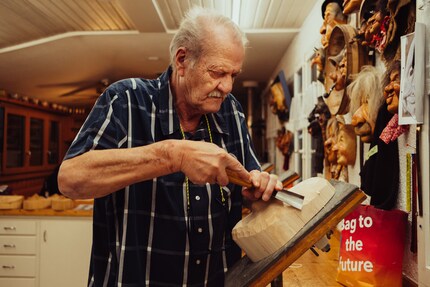
Bruno’s the president of the society Schnitzerfreunde Flums (carving friends Flums). We say a quick hello and then head to the basement of the town hall where the Sarganserland Mask Museum is. 200 contemporary as well as historical masks from all eight municipalities of the region adorn the lime plaster walls of the vaulted cellar. «The tradition goes back to South-German and South-Tyrolean carvers who produced sacred commissioned works in the 19th century. The curious locals started carving themselves. When the Sargans region was plagued by famine 200 years ago, many fathers needed extra income to support their families, so they chopped wood or sold masks,» Bruno tells me.
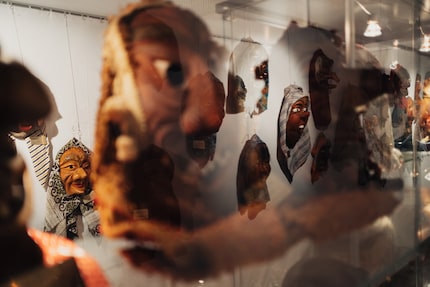
This is how the craft slowly became a tradition in the region. Bruno’s been living this tradition for over 30 years. He used to be member of a Swiss carnival society, but didn’t only want to support the tradition of wearing traditional masks, but also of manufacturing them. In 1991, he and a few other Flums carvers founded the society Schnitzerfreunde Flums. Bruno’s been the president ever since.
I get to see Bruno's skills right away, as some of his masks made it into the exhibition. The tiny dentist mask is one of them. «I took my son to Chur for his annual checkup at the dentist’s. There was a small plaster figure in the waiting room that was supposed to represent a dentist. It inspired me to create a mask, so I made a sketch of it.» He spent 80 hours carving the face – usually, this would take about 35 to 40 hours. The mask he created is of a patient’s face with a tiny dentist hanging out of the mouth. The miniature dentist is working on a canine tooth. «The teeth are from a cow, and the rest is carved entirely from one piece of linden wood.»
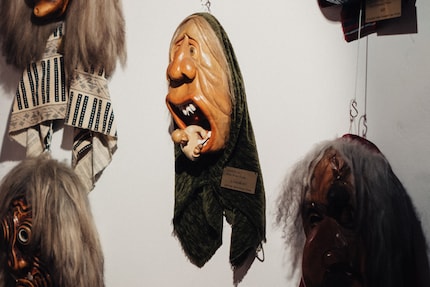
As we’re moving from the theoretical to the practical aspects of carving, Bruno leads me back through the sleepy village. 25 years ago, the Schnitzerfreunde took over the old clubhouse of the football club, FC Flums. After about 3,500 hours of voluntary work, the carvers set up their workshop there. Outside the building, to the left of the entrance, faces have been carved into the trunk of an old linden tree. They smile at everyone who enters the clubhouse. I’m guessing they’ve seen a lot – at least this is what the deep furrows suggest that run from their forehead to their cheeks. «The tree was chopped down and given to us for free. This much wood would usually cost a fortune. Unfortunately, the linden tree was completely rotten on the inside, so only the trunk remained. But I managed to make something out of it,» Bruno says.
Besides doing carving work, the ten club members regularly give carving courses. The goal of these courses is for every participant to take home a beautiful, ready-to-wear mask. «This means we rely on help to complete the works,» says Romy. She joined five years ago, making her the latest member of the club – and the only woman. «I keep searching for female support, but none of my friends are up for it.»
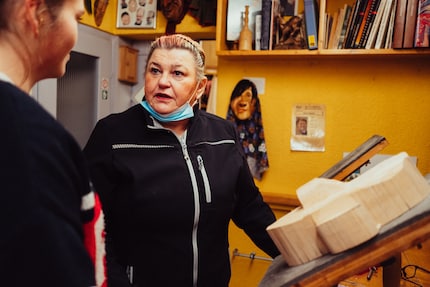
Step by step, Romy explains to me how a mask is made. She’s at her workplace – every member has their own – and flips through countless pages of illustrated instructions that all beginners follow. The first thing to do is mark the wood with a pencil. The facial features need to be marked onto the wood in an anatomically correct way. «Most people set the eyes too high up on the face, as they forget to include the hairline,» Bruno explains. Once this is done, the carving tools come into play. The flat carving chisel is used to tackle the nose. «It marks the highest point of the face, so it has to be carved out first.» The nose is followed by the eyes, the laughter lines and the mouth. When everything is done, the mask is hollowed out so that it fits over the face. «In carving circles, we believe that every mask should be worn at least once,» Bruno says.
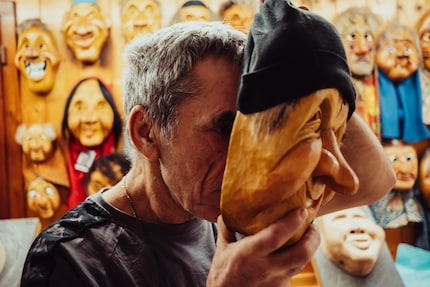
«When I'm carving, I forget about everything else and am fully concentrated on every cutting stroke,» says Heiri. He’s been part of the club for 20 years and is currently sharpening his tools. «I'm a polymechanic. I work with hard metal all day, so working with soft wood is a welcome change.» Many other members seem to agree, as there are locksmiths, precision mechanics and other mechanics among the club members. But it's not just the solitary carving that draws members to the clubhouse every Tuesday, but also the company.
They share anecdotes, crack jokes about each other, and offer me a glass of their own Schnitzerfreunde schnapps: «It’s homemade and the label includes our logo,» Romy tells me, before we clink glasses, with almost everyone joining in. Only Beat keeps working intently at his workstation. «He probably has to get commissioned work done,» Bruno says.
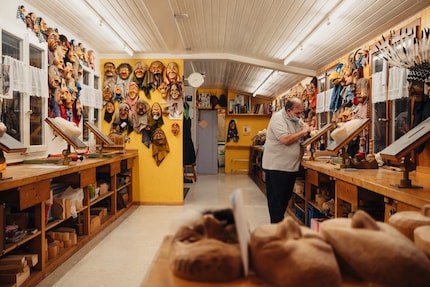
Schnitzerfreunde masks are in demand. Their works have appeared at the Swiss men’s ski championship, at Schwinger events and at the international mask exhibition in New Delhi, among others. «By now, there’s at least one of my masks on every continent,» Bruno says almost as a side note.
The most popular mask is called «Chrottni». It’s the most famous mask from Flums. «About 100 years ago, a woman lived in this village who knew more than anyone else. She couldn’t keep all this knowledge to herself and shared it with everyone she met on the village square. It soon became clear where she got all the gossip from: she was the postman’s wife and had been secretly opening and reading all letters.» This was good fodder for the carnival societies and carvers who liked to caricature village originals. «People who had a special backstory or a noticeable physical feature were bound to be incorporated into the carnival in some way.»
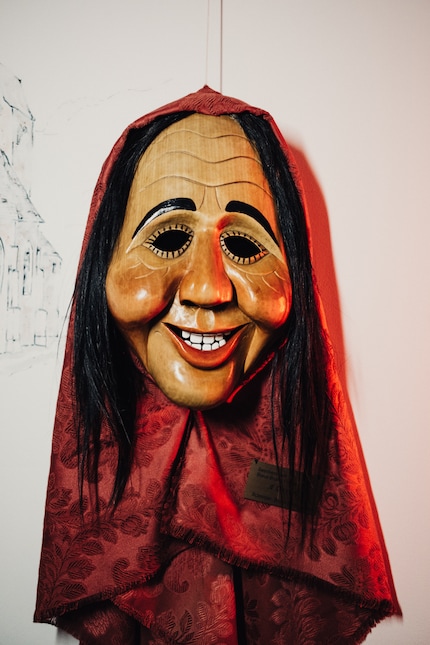
The Swiss carnival – it’s referred to as «Butzne» in the Sargans dialect – is traditionally Catholic and allows people to go all in one last time before Lent. People can slip into a different role, which helps reduce inhibitions. «That’s how people would dare to give someone like their boss a tongue-lashing,» Bruno says. According to Bruno, the Butzne has lost some of its charisma, due to the people who live in Flums. «Many new people have moved here over the past few years, which is great. But they don’t yet have a connection to the village and its traditions.»
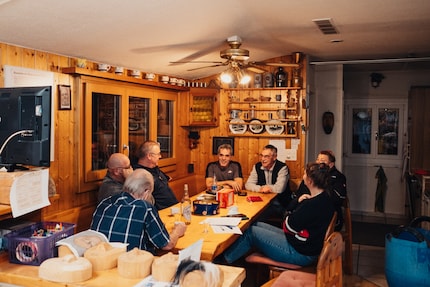
This doesn’t apply to the ten Schnitzerfreunde. They keep the tradition alive week for week. Everyone’s own masks are on display on the wall behind their workstation. All members have their own style, which is sometimes even notable for untrained eyes. Romy often creates faces with floral elements and «they always have ears. I don’t like them without.» Bruno, on the other hand, carves without leaving traces of the knife. As if he’d sanded the surface down. Marcus, Bruno’s neighbour and the only active member of a carnival group (at least for this year, after that no more), often carves caricatures and Krampus masks. A Krampus is a horned, anthropomorphic figure in Central and Eastern Alpine folklore.
But everyone’s masks originate from a 13-centimetre block of wood. Sometimes it’s Weymouth pine, sometimes Canadian cedar, but 90 per cent of the time it’s linden wood. «The wood has to dry for at least four years before we can use it for carving. First, the bark is removed so that the wood isn’t eaten by worms. Then it’s stacked in a place where it’s protected from the weather,» Marcus explains.
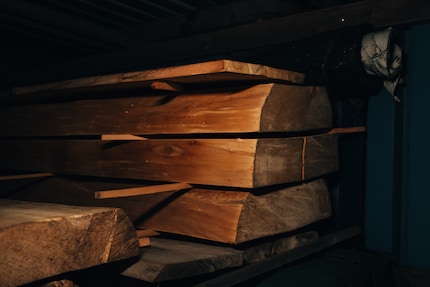
With some Dutch courage, I also dare to do some carving. My first task is to draw the eyes onto the wood. That’s too much for me already. I move the pencil really carefully, but end up getting some praise: «You didn’t need an eraser at all, well done!» Inspired by Bruno’s words, I dare to carve with more self-confidence. I barely move the flat chisel more than five millimetres and am already doing it wrong. «You need to let the knife glide,» says Marcus, who’s been watching and proceeds to show me what he means. He doesn’t put as much pressure onto the tool, but let’s it glide over the wood. «The wood will guide the way. Your hand just needs to follow.» I try, but it doesn’t really work. I apply the carving tool again. And then again. I make minimal progress.
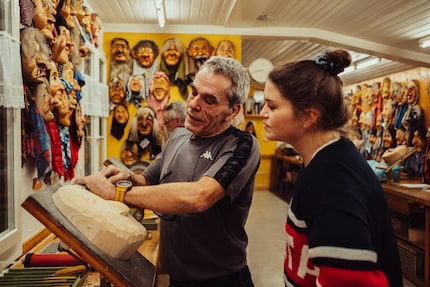
As I slowly move the chisel over the linden wood with my right hand and stabilise it with my left, everything outside the diameter of this unfinished face begins to blur. Every cut keeps the Sarganserland mask tradition alive. Every cut ensures that the story of the «Chrottni» is still be told 100 years from now. I’m beginning to understand how these people can dedicate themselves fully to this craft.
«When’s your train home?» – Bruno's words wake me from my daydreaming. It’s only now that I realise how late it is. I rely on the timetable of the Swiss Federal Railways. And there aren’t many trains at this time of day. That’s why the goodbye is just as brief as the welcome was. I leave the Schnitzerfreunde’s warm clubhouse and go out into the empty streets, where buildings from the 70s and former workers’ housing estates merge seamlessly. I pass desolate meadows and closed hair salons.
Time to get back to the station with no display boards.
My life in a nutshell? On a quest to broaden my horizon. I love discovering and learning new skills and I see a chance to experience something new in everything – be it travelling, reading, cooking, movies or DIY.
Interesting facts about products, behind-the-scenes looks at manufacturers and deep-dives on interesting people.
Show all